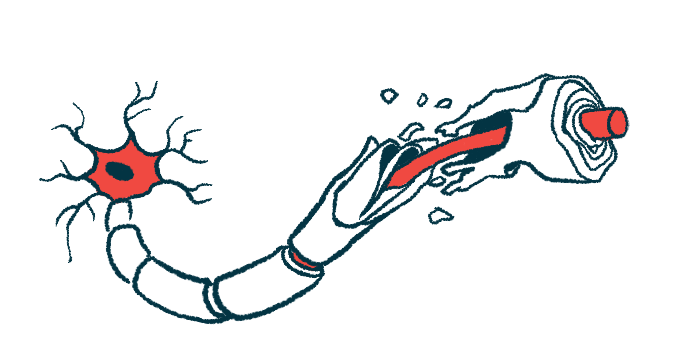NfL blood test may detect neurodegeneration in youngsters
Already a biomarker for adults, its use can be extended to children, study finds

Neurofilament light chain (NfL) protein levels can be used to assess neurodegeneration in children and adolescents with neurological disease, including multiple sclerosis (MS), even when they are not experiencing any symptoms, a study has found.
The protein already had been established as a biomarker of disease activity and poor response to treatment in adults with MS, and findings suggest its use can be extended to children and adolescents with neurological conditions, helping to detect nerve damage earlier and more frequently than current methods.
“NfL can tell doctors how to manage MS after a diagnosis is made and treatment is started,” lead author Ahmed Abdelhak, MD, clinical instructor of neurology at University of California San Francisco, said in a university news story. “If NfL is high in a child, even if they appear well, it suggests the disease is not stable and other treatment strategies should be considered.”
The study, “Serum neurofilament light chain reference database for individual application in paediatric care: a retrospective modelling and validation study,” was published in The Lancet Neurology.
Neurofilaments are fiber-like clusters of proteins that provide structural support for nerve cell projections called axons. When nerves are damaged, components of neurofilaments such as NfL leak into bodily fluids, including the bloodstream.
As such, elevated NfL levels in blood samples have become an indirect method to measure disease activity in neurological disorders like MS, which is caused by an autoimmune attack on the brain and spinal cord.
However, factors such as age and body weight can influence NfL levels, which can complicate the interpretation of results. For example, high levels in one person can be within the normal range for someone else.
Last year, an age- and BMI-adjusted reference set of NfL levels in serum (blood without cells) in adults was established to predict disease activity and capture treatment responses in MS. BMI, or body mass index, is a ratio of weight to height.
Based on these findings, the U.S. Food and Drug Administration granted breakthrough device designation to an NfL blood test for measuring the risk of MS activity in adults. The regulatory status is intended to speed the test’s potential regulatory approval as a standard assessment tool.
Now, an international team of scientists created standard ranges of the NfL biomarker in children and adolescents with and without neurological diseases. Such conditions included early-onset MS, as well as epilepsy, traumatic brain injury, bacterial infections of the nervous system, and myelin oligodendrocyte glycoprotein antibody-associated disease (MOGAD), a condition similar to MS.
NfL blood test much less expensive
“NfL blood tests are much cheaper than MRI and might be repeated every few months if needed, while an MRI might be done at longer intervals,” said study co-lead Jens Kuhle, MD, at the University of Basel in Switzerland, who also is a senior author of the adult study.
“Testing NfL may help monitor disease activity in patients who are not yet on [disease-modifing therapies], as well as in future clinical trials, in which it might one day partially replace MRIs,” Kuhle said. “This would simplify the study and decrease costs.”
Blood serum samples were collected from 2,667 healthy children and adolescents, ages 0-22 years, with equal numbers of boys and girls. Generally, NfL levels decreased by about 6.8% per year until age 10.3 years. After that, NfL was mostly stable up to the age of 22.
Regarding body weight, a 10 kg (22 pounds) increase in weight in children 10.3 years or younger was associated with an estimated 8.8% decrease in NfL concentrations. Beyond this age, body weight was the only factor that correlated with NfL levels — but the effect was smaller, with a 10 kg increase in weight associated with an estimated 3.7% drop in NfL.
Online app used to calculate NfL values
Based on these findings, the team derived NfL age-related Z scores, the difference between a raw measurement and the population mean, and percentiles, or how a score compares to other scores. An online app was created for researchers and clinicians to calculate NfL-based values for children and adolescents.
To validate the clinical utility of the reference database, samples from 220 children and adolescents with neurological conditions were tested; of those, 142 had pediatric-onset MS.
While both raw NfL values and NfL Z scores were significantly higher than in the reference population, Z scores were better at distinguishing between various neurological diseases and healthy children and adolescents.
Among the 142 participants with pediatric-onset MS, the median NfL level was 21.2 picograms per milliliter (pg/mL), much higher than the median 4.8 pg/mL observed in the healthy controls, representing a median Z score of 2.8 above the population mean.
“Similar to in the adult population, sNfL is likely to have a relevant contribution to the counselling of children with paediatric neurological conditions,” the researchers wrote.
“Paediatric neurological diseases contribute substantially to paediatric disability burden worldwide. The normative values established for sNfL for the paediatric population in this study represent a crucial advance to overcome existing constraints in interpreting raw values, and provides the foundation for the clinical use of blood NfL measurements in this population,” they added.
“Use of age-adjusted NfL concentrations in children and adults means that we do not have to limit the wide-scale application of NfL in clinical settings to a specific age-group,” Kuhle added. “For MS patients, we have a sensitive test that can measure disease activity and quantify treatment response.”







